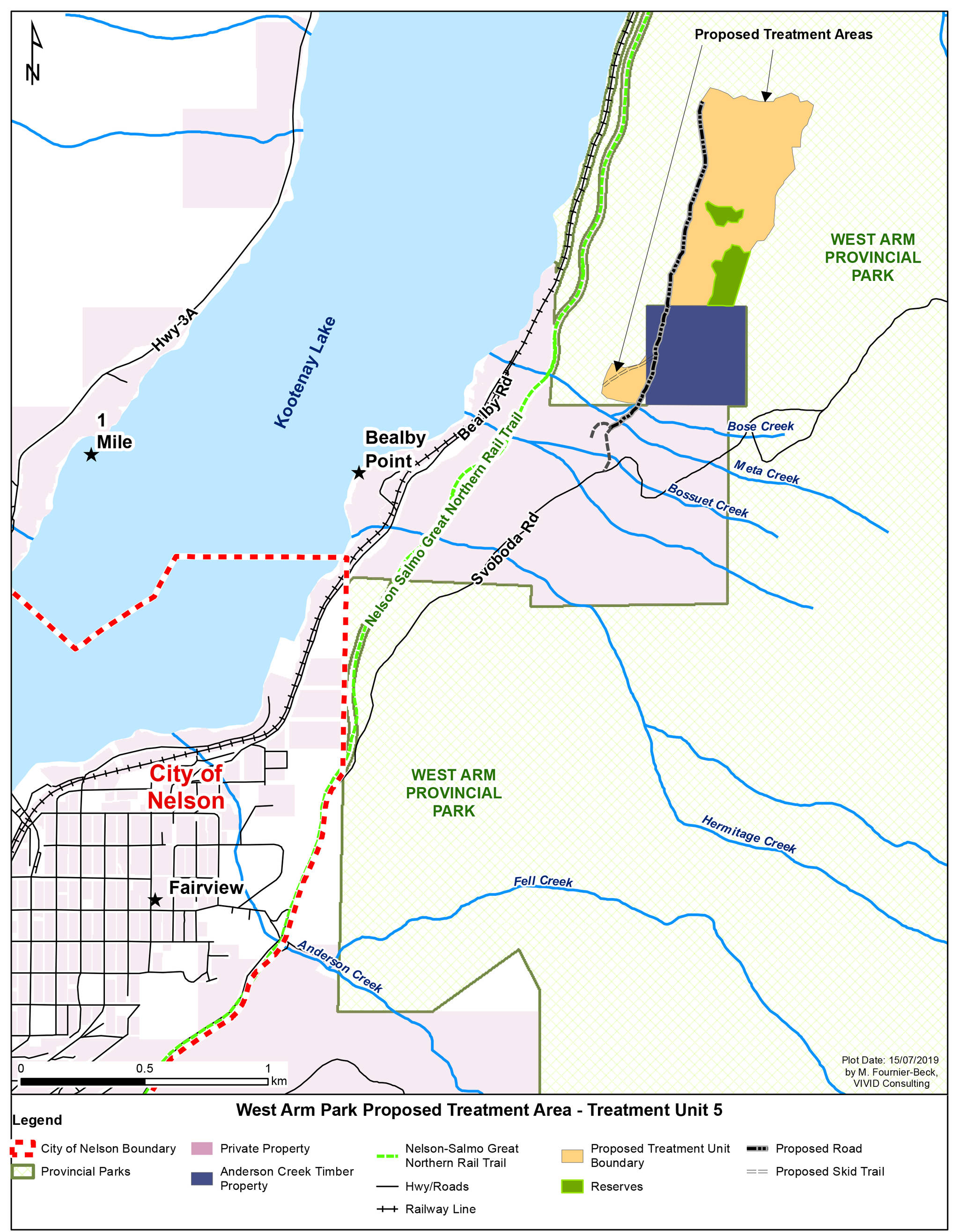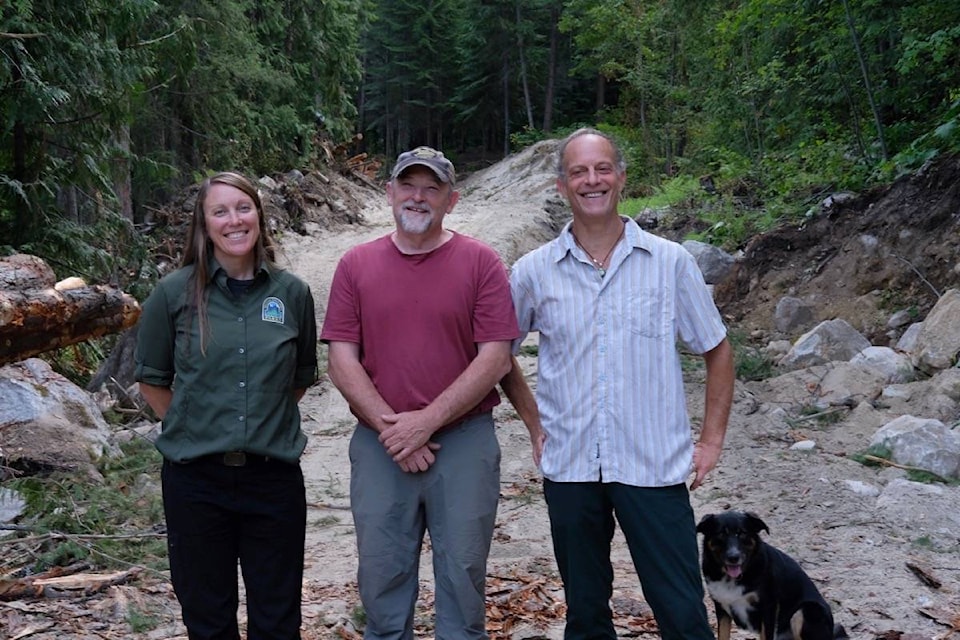Third in a series about wildfire protection in the Nelson area
Part one was “Kalesnikoff to collaborate with RDCK, city, on logging near Nelson” and Part two was “Nelson creates rules for wildfire resistant landscaping and building”
An unlikely three-way partnership is working to reduce the wildfire danger in the forest northeast of Nelson.
BC Parks, Anderson Creek Timber Properties, and a group of Svoboda Road residents will collaborate to build a road that will allow crews to carry out fuel treatment in a 28-hectare section of forest in West Arm Provincial Park (see map below).
That forest contains what wildfire experts call “extensive fuel loading”: lots of large deadfall and dry underbrush, much of it so thick and deep it’s nearly impossible to walk through. The area has been identified by the Regional District of Central Kootenay as a priority area for fuel treatment (removing small diameter trees, surface fuel, and low hanging branches).
“It is very bad,” said Amanda Weber-Roy, conservation specialist at BC Parks. “The fuel loading is extreme.”
But there is currently no road to allow crews to get there.
Landowner: ‘We are vulnerable’
The new road, currently under construction in preparation for the fuel work in the park in the fall, will start at Svoboda Road and pass through a corner of a piece of land owned in common by eight households there.
One of those residents — whose share of the property the road will pass through for 75 metres — is Richard Klein.
“We live in a landscape that is clogged with dead and dying wood because fires have been suppressed over the last 80 years,” he said. “We are vulnerable, and I think people realize that although they might have done FireSmart work around their house, that does not guarantee anything if [a major fire] gets going. So this is the next step of being proactive.”
The cost of the road will be shared between BC Parks and Anderson Creek Timber Properties. Klein said the company is doing a good job of the road construction.
“It’s a gash across the landscape but nature will recover,” he said.
Timber company: ‘It is an extreme hazard’
The new road will then pass through land owned by Anderson Creek Timber (the purple block on the map), which also currently has no road access. This will let the company log the property and carry out fuel treatment.
“We have 16 acres of land there and we are looking at selectively logging most or all of it, to maybe 50 to 60 per cent area removal, depending on the economics at the time,” said the company’s Brent Petrick.
He said some of the dry fuel in his forest is as dangerous as in the park.
“It is waist deep. It is an extreme hazard. If it ever lights up, I am not sure anyone could stop it.”
He said when BC Parks and the landowner group approached him, he was glad to be involved.
“We are right beside the private land and parks is behind us, so it makes sense to join up all our prescriptions toward fuel mitigation, which will protect the city’s water and protect the community up there. It’s a very good project.”
This Anderson Creek property is separate from a much larger piece the company owns directly above Fairview.
“This is just the start of the partnerships that have to go into fuel management,” Petrick said, “with Crown land, private land, parks and the city, and it needs to happen right from Balfour all the way to Trail.”
BC Parks:
‘Tip of the iceberg’
The road will then continue for 850 metres into the park, where fuel treatment work will begin in the fall, although much more is planned for the park in the coming years.
“It is the tip of the iceberg,” Weber-Roy says. “We looked at the park as a whole and asked: where would be the most effective parts to treat? So we have this area on the Nelson side and some on the Harrop side.
“This will be a really effective fuel break.”
Weber-Roy says the budget for the fuel treatment work in the park is $100,000, with 80 per cent coming from the B.C. government’s Forest Enhancement Society and the rest from the B.C. Parks licence plate program, which has sold $150,000 worth of specialized licence plates at $40 per plate per year with proceeds to parks enhancement.
She said some logs may be taken out of the park but “any stumpage paid on the wood that comes out of the park goes into the park enhancement fund and I can use it for future treatments in this park.”
Doing fuel mitigation work is more complicated in a park than anywhere else, Weber-Roy said.
“Standards are more stringent. We have to do an impact assessment, consult with First Nations, do some wildlife monitoring. It is still caribou habitat even though they are not around. It is so fuel-loaded it is hard for them to move around.”
Drinking water
and mountain bikers
Outdoor recreation in the park also has to be considered.
“The Middle Earth Trail starts up in the park and goes down through Anderson Creek Timber and back through the park. We have got that closed right now, while we are in there working,” said Weber-Roy.
The forests in the park are the source of most of Nelson’s drinking water.
“Eighty-five per cent of the city’s water goes through a section of our land,” Klein said, “and continues west and east of our property. So this feels like we are pulling our weight.”
He said he will doing some logging on his property as well.
“I am anticipating taking out some volume so that a fire cannot pass as readily from canopy to canopy, and introduce some light so we can introduce fire resistant species. I am looking at how I can put in place the requirement for a fire resistant forest in 40 years time when the climate will be more extreme.”
Managed Forest Land
The Anderson Creek land is privately owned by the company and falls under a provincial designation called Managed Forest Land.
Managed Forest Land is overseen by the Managed Forest Land Council and has a number of requirements regarding such things as riparian widths, soil disturbance, and re-stocking, in return for provincial tax breaks.
Private land not designated as managed forest is unregulated with minimal environmental restrictions — for example, the controversial logging near Cottonwood Lake owned by Nelson Land Corporation.
Related:
• Kalesnikoff to collaborate with RDCK, city, on logging near Nelson

